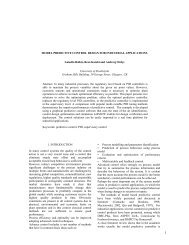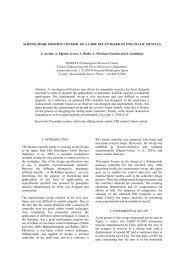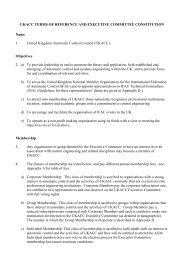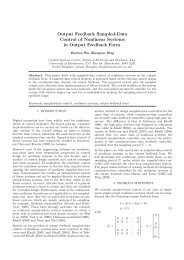ON PSEUDO-DIFFERENTIAL CALCULUS FOR DISTRIBUTED ...
ON PSEUDO-DIFFERENTIAL CALCULUS FOR DISTRIBUTED ...
ON PSEUDO-DIFFERENTIAL CALCULUS FOR DISTRIBUTED ...
Create successful ePaper yourself
Turn your PDF publications into a flip-book with our unique Google optimized e-Paper software.
<strong>ON</strong> <strong>PSEUDO</strong>-<strong>DIFFERENTIAL</strong> <strong>CALCULUS</strong> <strong>FOR</strong><strong>DISTRIBUTED</strong>-PARAMETER C<strong>ON</strong>TROLSYSTEMSMarkku Nihtilä Jouko Tervo Petri Kokkonen ∗∗ University of Kuopio, Department of Mathematics andStatistics, POB 1627, FI-70211 Kuopio, Finland{markku.nihtila; jouko.tervo; petri.kokkonen}@uku.fiAbstract: Pseudo-differential operator (ψDO) theory offers a mathematicallywell-founded means to study control and optimization problems of distributedparametersystems described by partial differential equations (PDE) with boundaryconditions. Furthemore, the theory includes transfer function-like propertiesfor boundary-value problems (BVP) of PDE systems like in the case of ordinarydifferential equation systems. Here we review some basic features of ψDOs andstudy application of ψDOs for open-loop control design in the light of a heatsystem. The idea in our application is to parametrize system variables of the PDEsby some external parameters (functions) as it is the case in flatness-based designfor ordinary differential equation systems. Then we can solve the system variablesas functions of the parameters. Examples of the parameters are the output of thesystem to be controlled or a reference signal to be tracked. Copyright c○ 2006 IFACKeywords: Partial differential systems, Parametrization, Pseudo-differentialoperators, Heat system, Open-loop control design.1. INTRODUCTI<strong>ON</strong>Our motivation for studying pseudo-differentialcalculus has its background in the concept of flatnessof ordinary differential equation (ODE) systems,and in the attempts to extend the conceptto partial differential equation (PDE) systems.Theory of flatness, developed by M. Fliess and coworkers(Fliess et al., 1992, 1995) for ODEs andsystems, introduced a new approach for controldesign and trajectory (motion) planning. Extensionsof flatness to PDE models, linear and nonlinear,were studied e.g. in (Laroche et al., 2000),(Lynch and Rudolph, 2000), (Ollivier and Sedoglavic,2001), (Petit and Rouchon, 2001). The1 Part of this work was done while M. Nihtilä was atthe Institute of Advanced Studies, SISSA, Italy, with thesupport of European Union’s 6th Framework Programme.extensions were based on infinitely differentiableGevrey functions and power series expansions.One of the key problems in developing controlmethodology for PDE systems is the inversionof the combined partial differential (PD) andboundary-value (trace) operator. Boundary conditions,always present in real-life problems, mustbe included in the problem statements. Theory ofpseudo-differential operators (ψDO), (Boutet deMonvel, 1971), (Grubb, 1995a & b), are used toovercome this problem.Distributed-parameter systems form a naturalframework in studying dynamic processes wherevalues of variables vary spatially even if theyare defined in some compact domain Ω ⊂ R nlike in non-ideally stirred flow and concentrationprocesses. Concatenation of different submodels,
however, needs sophisticated mathematics. This isdue to boundary conditions needed in a completeproblem statement with a boundary. In the case oflinear ODE systems transfer functions of systemscan be summed, multiplied and divided formingalgebras of transfer function matrices.1.1 Motivating examplesIt is known that the Fourier transform∫(Fu)(ξ) = û(ξ) = u(x)e −i〈x,ξ〉 dx (1)R nof the function u ∈ S(R n ), the Schwartz space ofrapidly decreasing functions, can be extended tothe dual S ′ (R n ), the Schwartz space of distributions,(Horváth, 1966).Example 1. (Grubb, 1997): Via the Fourier theory,one can solve the equation(1 − ∆)u = f on R n , (2)for ∆ = ∂2 + · · · + ∂2∂x 2 ∂x. If u, f ∈ S ′ (R n ), then12 n(1 + |ξ| 2 )û = ˆfand the unique solution is given byu = F −1( 1)1 + |ξ| 2 Ff .The function (1 + |ξ| 2 ) −1 is called the symbol ofthe operator 1 − ∆.Example 2. (Grubb, 1997): Consider the problem(2) in a bounded subset Ω ⊂ R n with a smoothboundary ∂Ω(1 − ∆)u = f in Ω, T u = ϕ on ∂Ω, (3)with the trace operator T : Ω → ∂Ω : u ↦→ u| ∂Ωforming the Dirichlet problem for 1 − ∆. Theproblem (3) has for f = 0 as a solution operator apotential operator K : ϕ ↦→ u, which is sometimescalled a Poisson operator. When ϕ = 0 in (3) ithas a solution operator called a Green operatorP : f ↦→ u. This operator splits into two components,i.e.P = r + A + B,where the operator A has the symbol (1 + |ξ| 2 ) −1in Ω and zero in R n \ Ω. The prefix operator r +restricts the solution back to Ω from R n . The operatorB is a singular Green operator. The generalsolution operator for nonzero f and ϕ can be givenin the form[ ] −11 − ∆= [ rT+ A + B K ] .The solution is obtained asu(x) = (r + Af)(x) + (Bf)(x) + (Kϕ)(x), x ∈ Ω.Pseudo-differential operator calculus has been refinedand further developed from earlier results in(Boutet de Monvel, 1971), and especially in a seriesof papers and books, see e.g. (Grubb, 1995a).The calculus has as its basic element, roughlycorresponding to a scalar transfer function a linearODE, the quadruple of operators (2×2-matrix) ofthe form [ r + ]A + B KA =. (4)T QIn fact, it includes the operators of the formappeared in examples 1 and 2, and an additionalpseudo-differential operator Q : ∂Ω → ∂Ω. Insome references this matrix operator A is called bythe name Green operator. These operators forman operator algebra, say D, under approppriateassumptions. Then if A, B ∈ D we have A ◦ B,A + B, A −1 ∈ D. This calculus is applicable forsystems described by partial differential operatorswith boundary conditions.Here we present the basic system structure formedby pseudo-differential and boundary value operators,introduce the general linear control system,give the definition of parametrization, andpresent some results. Parametrization means thatall the system variables, on the boundary and inthe domain, are represented as functions of theparameter (an arbitray function or a set of functionsliving in some specific function spaces) exactlyas in flatness-based control design of ODEs.Some explicit calculations for a heat equationwere carried out earlier. An extension to a nonlinearPDE system combining global linearizationand a parametrization was studied in (Nihtilä etal., 2004a).Our example, the heat system includes the explicitconstruction of a parametrization. Concluding remarkscomplete the paper.2. SOME NOTATI<strong>ON</strong> AND DEFINITI<strong>ON</strong>SSome basic notation and definitions are given inthe following for clarifying the formulas givenhere. N = {0, 1, 2, . . .}, α ∈ N n ,α = (α 1 , α 2 , . . .,α n ), |α| = α 1 + α 2 + · · · + α n ,x, ξ ∈ R n , ξ = (ξ 1 , ξ 2 , . . .,ξ n ), |ξ| 2 = ∑ ni=1 ξ2 i ,〈ξ〉 = ( 1 + |ξ| 2) 1/2 ∑ n , 〈ξ, x〉 =i=1 x iξ i , i = √ −1,∂D j = −i∂ j = −i∂x j, D α = D α11 Dα2 2 · · · Dαn n ,∂ α = (−i) |α| D α , ξ α = ξ α11 ξα2 2 · · · ξαn n , Thesubindices x and ξ are used in partial derivativenotations if there could be an ambiguity with thearguments.Consider a linear partial differential operatorp(x, D) = ∑p α (x)D α , (5)|α|≤mwhere the coefficients p α (x) are some smoothfunctions, affecting on a function u in a relevantfunction space, e.g. u ∈ S(R n ). It is known that
this effect can be expressed in the following integralformp(x, D)u = (2π) −n ∫R n e i〈x,ξ〉 p(x, ξ)û(ξ)dξ. (6)The function p is called the symbol of the operatorp(x, D). It is obtained from (5):p(x, ξ) = ∑p α (x)ξ α . (7)|α|≤mIn the case of PD operators the symbol is amultipolynomial. More general operators wherethe symbol is not limited to polynomials can alsobe described by the same integral formula (6).Then, for example, the solution operator ofp(x, D) = p(D) = (1 − ∆),which has the symbol q(ξ) = (1 + |ξ| 2 ) −1 , belongsto the same calculus, and it can be represented inthe form (6).The ΨDOs are classified based on properties oftheir symbols. In order to study parabolic (i.e.evolution) problems of the form∂ t u + r + Au + B u = f ; (x, t) ∈ G × I,T u = ϕ ; (x, t) ∈ ∂G × I,u(x, 0) = u 0 (x) ; x ∈ G,(A is elliptic, e.g. A = ∆, G is a singular Greenop.), so-called parameter-dependent calculus wasdeveloped, see (Grubb, 1995a & b). Then in evolutionproblems a typical parameter-dependentoperator is of the form[ r + ]A + B − λIA λ =. (8)T3. MODELS AND PARAMETRIZATI<strong>ON</strong>A linear distributed-parameter control system canusually be expressed in the form Lu = 0, wherethe components of u = (u 1 , . . .,u N ) are indeterminatesin appropriate function spaces. L is alinear operator including e.g. partial differentialoperators (with boundary values). In standardevolution problems L may be of the form⎛ ⎞ ⎡⎤∂vL⎝ v wy⎠ =⎢⎣− Av − Bw∂t ⎥T v + Rw ⎦ (9)y − Cv − Dw⎧⎨ v = (v 1 , . . .,v n ) − statew = (w 1 , . . .,w m ) − input⎩y = (y 1 , . . . , y l ) − output(10)A is a (spatial) partial differential operator, B, C,and D may contain other types of operators,e.g. integral and/or trace operators. The middleequation includes the boundary conditions via thetrace operators T and R.3.1 Control systemLet G be an open bounded set in R n with asmooth boundary ∂G, and let I be and intervalin R. The control system considered in componentwiseform (i = 1, . . . , N 1 in (11), and p =1, . . .,m 1 in (12)) isN∑ (r + )m∑A ij + B ij vj + K il w l = 0, (11)j=1j=1l=1N∑ m∑T pj v j + Q pl w l = 0, (12)l=1where (11) is the domain equation and (12) isthe boundary equation. The operators are of thefollowing type:- r + A ij : C ∞ (G × I) → C ∞ (G × I), ψDO- T pj : C ∞ (G × I) → C ∞ (∂G × I), trace op.- K jl : C ∞ (∂G × I) → C ∞ (G × I), potential op.- B ij : C ∞ (G × I) → C ∞ (G × I), sing. Green op.- Q pl : C ∞ (∂G × I) → C ∞ (∂G × I), ψDO.The variables v j and w l are indeterminates, i.e.v j ∈ C ∞ (G × I); w l ∈ C ∞ (∂G × I). Denotefurther R N,m = C ∞ (G × I) N × C ∞ (∂G × I) m . Acompact form of the model (11)-(12) is given byLu = 0.Then L can be interpreted as a linear operatorwhere L =u =[ vw]L : R N,m → R N1,m1 , (13)[ (r + ) ( ) ]A ij + B ij Kil⎡ ⎤v 1⎢; v = ⎣ .v N(Tpj) (Qpl)⎥⎦; w =⎡ ⎤w 1⎢⎣ .w m; (14)⎥⎦. (15)The matrix operator L(∈ D(N 1 +m 1 , N+m)) is ofthe type (N 1 +m 1 ) ×(N +m) having submatricesmade by the operators appearing in (4).3.2 ParametrizationFor the purpose of the application of ΨDOs thedefinition of the term parametrization roughlycorresponding to flatness of ODEs is given. Thecontrol system (11)-(12) is said to be parametrizableif there exists an operatorS ∈ D(N + m, N ′ + m ′ ) (16)for some N ′ , m ′ ∈ N such thatLu = 0 ⇐⇒ u = Sf. (17)In the papers (Nihtilä et al., 2004a & 2005)some results on the existence and construction ofparametrizations are given.
4. THE HEAT SYSTEM REVISITEDThis problem has alredy been earlier studied froma construction point of view. Here the emphasislies in the relations between the solution formulaeand the general theory of singular Green operatorsof (Grubb, 1984).Consider the linear heat system∂u∂t = ∂2 u∂x 2 , u(x, 0) = g 0(x), (18)∂uu(0, t) = 1, (0, t) = −w(t), (19)∂xy(t) = u(1, t), (20)where u stands for the temperature, w the control,and y the output to be controlled.The goal is to drive the output y from one steadystatevalue y 0 to another y 1 in a finite time T, andkeep it in this new value. This corresponds to thedriving of system’s state u from one steady-stateprofile g 0 to another, say g 1 in a finite time. Thesteady-state profiles, because ∂u∂t= 0 and due tothe boundary conditions, areg i (x) = 1 + (y i − 1)x, i = 0, 1. (21)Here we look at the system from another point ofview. The output y to be controlled is consideredas the input, and the actual control as the output.The solution is given in the following.Theorem 1. A parametrization of the linear heatsystem (18)-(20) with the parameter (function)y(t) = u(1, t) is given byu(x, t) = (B y)(x, t) + g 0 (x) (22)∂u(x, t)w(t) = − ∂x ∣x=0= − ∂ [(B y)(x, t) + g 0 (x)] ∣ ∣∣ , (23)∂xx=0where the operator B is[By = [ Q + G K ]0(0, y(t) − y(0))The operators in B are as follows:]+ g 0 .(24)Q is a pseudo-differential operator X → XG is a singular Green operator X → XK is a potential operator Y → Xwhere X = C ∞ (G × I) and Y = C ∞ (∂G × I).The construction of B is based on the inversion ofthe parameter-dependent operator⎡ ⎤[ ]AλA λ = = ⎣ − ∂2T ∂x 2 − λI ⎦ (25)Taccording to the example 2 of section I for λ ∈C −ǫ = { λ ∈ C | Rλ ≥ −ǫ }. I is the identityoperator, and the trace operator T is given byThen A −1λT v = (v(0, λ), v(1, λ)) (26)exists and it has the formA −1λ = [ Q λ + G λ K λ ] (27)The operator B is given in (Grubb, 1995a) byB = L −1 A −1λL, (28)where L is the Laplace transform, and L −1 itsinverse.4.1 Explicit SolutionThe resolvent operator (A−λI) −1 of the operatorA in the equation A λ = A L is simply(A − λI) −1 = Q λ + G λ , (29)where now the parameter is the variable λ. Theexplicit forms for the given f(x, λ) are in integralform (µ = √ λ )(Q λ f)(x, λ) = − 1 ∫e iξx2π R ξ 2 − λ ê+ f(ξ, λ)dξ (30)(G λ f)(x, λ) = sin(µx) ∫e iξ2π sinµ R ξ 2 − λ ê+ f(ξ, λ)dξ (31)∫sin(µ(1 − x)) 1+2π sinµ ξ 2 − λ ê+ f(ξ, λ)dξ. (32)The potential operator component isRK λ = [I − (Q λ + G λ )(A − λI)]K ′ . (33)The remaining potential component on the boundary{0, 1} was chosen as (g(λ) = (g 1 (λ), g 2 (λ)),parameter-dependent values on the boundary)(K ′ g)(x, λ) = (1 − x)g 1 (λ) + xg 2 (λ). (34)The solution operators Q λ + G λ were in thisexample case obtained by directly solving of the(Laplace transformed) system on [0, 1] × C −ǫ(A − λI)v 1 = f,v 1 (0, λ) = 0, v 1 (1, λ) = 0.Via residual calculus and Cauchy’s principal valuetechniques the operator values of (Q λ f)(x, λ) and(G λ f)(x, λ) for the function f(x, λ) = (K ′ g)(x, λ)were calculated. By using of these results we obtainthe Laplace transformed temperature U andcontrol W in the form (µ = √ λ)U(x, λ) =W(λ) = −(2x − sin(µx)sin µ(2 − µsin µ)V (λ) + g 0(x)λ , (35))V (λ) − g′ 0 (0)λ , (36)V (λ) = L{y(t) − y(0)}. (37)
4.2 Construction via Transmission PropertyAn alternative method, which may have a moregeneral significance, to construct the singularGreen operator (SGO) G λ is based on the Transmissionproperty (Grubb and Hörmander, 1990) ofthe overall operator Q λ +G λ , and on the discussionin (Grubb, 1984) on the structure of SGOs. Theeffect of the SGO G λ can be represented as a productof the trace operator and potential operatorapplied on Q λ f:G λ = ¯K λ ¯Tλ Q λ . (38)On the boundary ∂G due to continuity((A − λI) −1 f ) ∣ ∣∂G= 0. (39)In our specific heat problem this reads((A − λI) −1 f ) (0, λ) = 0,((A − λI) −1 f ) (1, λ) = 0.In general, the SGO is a sum of products ofthe type (38) (Grubb, 1984). Denote φ(x, λ) =(Q λ f)(x, λ). Then ( ¯T λ φ)(λ) = (φ(0, λ), φ(1, λ)) .Application of a potential operator ¯K λ needs twocoefficient functions, say α 0 (x) and α 1 (x) giving(G λ f)(x, λ) = α 0 (x)φ(0, λ) + α 1 (x)φ(1, λ).Due to the boundary conditions, one obtains∂u∂t (x i, t 1 ) := u(x i, t 2 ) − u(x i , t 1 ),t 2 − t 1∂u∂t (x i, t j ) := u(x i, t j+1 ) − u(x i , t j−1 ),t j+1 − t j−1j = 2, . . .,m − 1,∂u∂t (x i, t m ) := u(x i, t m ) − u(x i , t m−1 ),t m − t m−1for i = 1, . . .,n. The heat equation is solved asu(x i+1 , t j ) = h 2 ∂u∂t (x i, t j )+2u(x i , t j )−u(x i−1 , t j ).Calculation proceeds as follows. First initial datais obtained from the first equation. Thus we knowu(x i , t j ) for i = 1, 2 and j = 1, . . .,m. Supposeinductively we know u(x i , t j ) for i ≤ k andj = 1, . . .,m. Then from the second equation wecalculate discretized derivatives ∂u∂t (x k, t j ), j =1, . . .,m and then from the last equation weobtain u(x k+1 , t j ), for j = 1, . . .,m. As we getk = n we terminate the algorithm.3.532.52Desired output1.50 5 10 15 20 25α 0 (0) = −1; α 0 (1) = 0, α 1 (1) = −1; α 1 (0) = 0.Direct computation inside the domain G via therequirement(((A − λI)(Qλ + G λ ))f ) (x, λ) = f(x, λ)2.221.81.61.41.21Calculated input0.80 5 10 15 20 25gives differential equations for α 0 and α 1α ′′i + λα i = 0; i = 0, 1.Solutions are the coefficient functions in (31)-(32).Fig. 1. Upper curve represents the desired rampoutput y (the parameter). Lower figure depictsthe corresponding (reference) input w.5. SIMULATI<strong>ON</strong> STUDYA piecewise linear function is applied for theparameter y (see Fig. 1). The values applied inthe simulation are: y 0 = 2; y 1 = 3.Based on the desired output in Fig. 1 the controlw, given in Fig. 1, was calculated via (36) &(37). Then this control was applied in the heatsystem by using a difference method to calculatethe temperature profile of Fig. 2.Difference method used. Suppose the control w(t)is given. G = [0, 1] and the time interval [0, T]are discretized as 0 = x 1 < x 2 < · · · < x n = 1,and 0 = t 1 < t 2 < · · · < t m = T. The spatialstep length is h = 1/n. Initial conditions arediscretized, for j = 1, . . .,m, asu(x 1 , t j ) = 1, u(x 2 , t j ) = −hw(t j ) + u(x 1 , t j ).Derivatives are calculated asx32.82.62.42.221.81.61.41.2110.80.60.40.20t0Fig. 2. Solution u(x, t) of the heat system (18)-(20) calculated by the finite difference schemewhen G = [0, 1] and t ∈ [0, 25].6. SOME C<strong>ON</strong>CLUDING REMARKSHere we presented some background of pseudodifferentialoperator theory. ψDO theory offers awell-founded means to study control issues for510152025
systems of PDEs. From the mathematical viewpointthe operator domains of ψDOs have beenextended from C ∞ -functions to Schwartz distributionsin S ′ (R n ). Consequently, we do not needto worry about ordinary differentiability of thefunctions at hand. Parameter-dependent ψDOsare applied to study our evolution (heat) system.Then the Laplace variable λ serves as the parameter.Parameter-elliptic theory (Grubb, 1995a)could then be applied. Despite the hard functionalanalysis applied in developing the ψDO theory, itsapplicability for control design is challenging.Another incredient here is the parametrizationconcept similar to the flatness issue of ODE systems.Then we can avoid the use of specific functionsand series expansions in the control design.In nonlinear problems, in order that our approachcould be used, global linearization is one of thepotential alternatives, see the viscous nonlinearBurgers’ system studied in (Nihtilä et al., 2004a).One of the key ideas in this nonlinear context isgiven in an old but still a very relevant paper(Kumei and Bluman, 1982).The simulations were carried out by using a finitedifferencemethod. The open-loop control, neededto produce the desired output in the heat system,was calculated via our parametrization method.Due to numerical inverse transforms there aresome chattering in the reference input w(t), whichactually do not exist in the theoretical solution.7. ACKNOWLEDGMENTThis work was supported by the European Commission,in Marie Curie programme’s Transfer ofKnowledge project Parametrization in the Controlof Dynamic Systems (PARAMCOSYS, No:509223). This support is greatly acknowledged.REFERENCESBoutet de Monvel, L. (1971). Boundary-problemsfor pseudo-differential operators. Acta Math.126, 11-51.Fliess, M., J. Lévine, Ph. Martin and P. Rouchon(1992). Sur les systèmes nonlinéaires differentiellementplats. C. R. Acad. Sci. ParisI-315, 619–624.Fliess, M., J. Lévine, Ph. Martin and P. Rouchon(1995). Flatness and defect of nonlinear systems:introductory theory and examples. Int.J. Control 61, 1327–1361.Grubb, G. (1984). Singular Green operators andtheir spectral asymptotics. Duke MathematicalJournal 51, 477–528.Grubb, G. (1995a). Parameter-elliptic and parabolicpseudodifferential boundary problems inglobal L p Sobolev spaces. MathematischeZeitschrift 218, 43-90.Grubb, G. (1995b). Functional Calculus ofPseudo-Differential Boundary Problems, 2nded. Birkhäuser. Boston.Grubb, G. (1997). Pseudodifferential boundaryproblems and applications. JahresberichtDeut. Math.-Verein 99, 110–121.Grubb, G. and L. Hörmander (1990). The transmissionproperty. Math. Scand. 67, 273–289.Horváth, J. (1966). Topological Vector Spaces andDistributions. Addison-Wesley. Reading, MA.Hörmander, L. (1983-85). The Analysis of LinearPartial Differential Operators, Vols. I-V.Springer. Berlin.Kumei, S. and G.W. Bluman (1982). When nonlineardifferential equations are equivalent tolinear differential equations. SIAM J. Appl.Math. 42, 1157–1173.Laroche, B., Ph. Martin, and P. Rouchon (2000).Motion planning for the heat equation. Int. J.Robust and Nonlinear Control. 10, 629–643.Lynch, A.F. and J. Rudolph (2000). Flatnessbasedboundary control of coupled nonlinearPDEs modelling a tubular reactor. In: Proc.Int. Symp. on Nonlinear Theory and its Appl.NOLTA2000. Vol. II. Elsevier. Dresden, 641-644.Nihtilä, M., J. Tervo, and P. Kokkonen (2004a).Control of Burgers’ system via parametrization.Preprints. 6th IFAC Symp. NonlinearControl Systems, NOLCOS 2004. (FrankAllgöwer, Ed.), Germany, 1, 423–428.Nihtilä, M., J. Tervo, and P. Kokkonen (2004b).Pseudo-differential operators in parametrizationof boundary-value control systems. In:CD-ROM Proceedings of the 34rd IEEE Conferenceon Decision and Control, CDC’04,14-17 December, Paradise Islands, The Bahamas.pp. 1958-1963.Nihtilä, M., J. Tervo, P. Kokkonen, and O.Sarafanov (2005). Parametrization and controlof partial differential systems. In: Proc.IV Int. Conf. System Identification and ControlProblems, SICPRO’05, 25-28 January.(K.R. Chernyskov, Ed.), V.A. TrapeznikovInstitute of Control Sciences, Moscow, Russia,ISBN 5-201-14975-8, pp. 767–785.Ollivier, F. and A. Sedoglavic (2001). A generalizationof flatness to nonlinear systems of partialdifferential equations, Application to thecommand of a flexible rod. In: NOLCOS’01,5th IFAC Symposium on Nonlinear ControlSystems. Saint-Petersburg, Russia, 4-6 July,pp. 196–200.Olver, P.J. (1993). Applications of Lie Groupsto Differential Equations. 2nd ed. Springer-Verlag. New York.Petit, N. and P. Rouchon (2001). Flatness ofheavy chain systems. SIAM J. Control Optim.40, 475–495.








